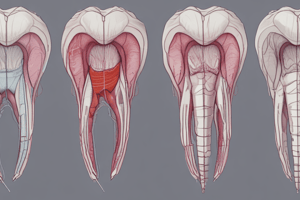Podcast
Questions and Answers
Which layer of cells underlines the ectoderm in the primitive oral cavity?
Which layer of cells underlines the ectoderm in the primitive oral cavity?
- Mesoderm
- Ectomesenchyme (correct)
- Endoderm
- Neural crest cells
What type of cells make up the ectoderm in the primitive oral cavity?
What type of cells make up the ectoderm in the primitive oral cavity?
- Columnar cells
- Squamous cells
- Flat cells
- Basal cuboidal cells (correct)
What do the morphological stages of tooth development refer to?
What do the morphological stages of tooth development refer to?
- Changes in the morphology of the developing tooth germ (correct)
- Changes in the size of the developing tooth germ
- Changes in the shape of the developing tooth germ
- Changes in the function of the developing tooth germ
What do the histophysiological stages of tooth development refer to?
What do the histophysiological stages of tooth development refer to?
During tooth development, at what stage does the condensation of ectomesenchyme occur?
During tooth development, at what stage does the condensation of ectomesenchyme occur?
What is the primary epithelial band?
What is the primary epithelial band?
How many maxillary odontogenic epithelial islands form during tooth development?
How many maxillary odontogenic epithelial islands form during tooth development?
What leads to the formation of the primary epithelial band?
What leads to the formation of the primary epithelial band?
What do the primary epithelial bands correspond to in the future dental arches?
What do the primary epithelial bands correspond to in the future dental arches?
Flashcards are hidden until you start studying




